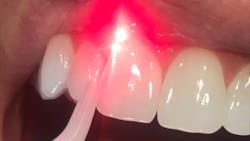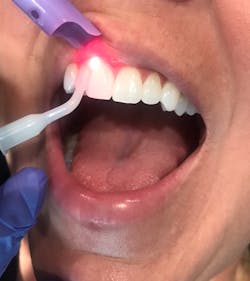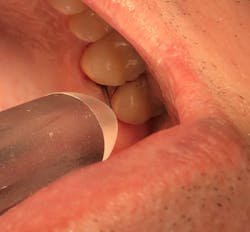Some people think that lasers are new, but they’ve been around for a few decades. At first, many clinicians didn’t think that lasers worked … they thought they were just something to get patients to spend their money on. But over time and from many studies, lasers have proven their place in dentistry and in the hands of dental hygienists.
We now see patients seeking out what lasers can do for them, as well as researchers and clinicians who continue to place the highest value on their capabilities. In addition, more and more “everyday” clinicians are looking to see how lasers can increase their practice efficiency and profitability.
How hygienists can use dental lasers for infection control during the pandemic and beyond
Canker sores: An old enemy facing new treatment
To begin your journey and get the most out of what lasers can do for your practice as a hygienist, the best place to start is with education. Start by doing your homework. Familiarize yourself by reading industry publications about lasers, take a few online classes, and attend some courses. Compare laser manufacturers and their offerings to discover which laser will work best for you, as well as finding a laser course that meets your needs.
Depending on your state, some common procedures dental hygienists can perform with lasers are laser bacterial reduction (figure 1) and laser-assisted periodontal therapy (figure 2).1-3
Laser bacterial reduction (LBR) can be used to eliminate bacteria at any hygiene appointment prior to completing hygiene procedures. LBR is the practice of administering low-power laser energy within the sulcus throughout the entire dentition. This helps to reduce bacteremia, cross-contamination, and bacterial load, which, in turn, helps prevent attachment loss. This procedure is not used in the depths of periodontal pockets; it is more like a “preprocedural rinse.”4
Laser-assisted periodontal therapy (LAPT) can be used for active periodontal therapy (SRP with laser decontamination) and in conjunction with traditional deep scaling appointments. LAPT is the practice of administering laser energy within the periodontal pocket for profound decontamination. LAPT also results in increased tissue interaction by removing the inflammatory factors, significantly reducing bacteria within the pocket, and consequently promoting growth factors for healing with the goal of tissue rehabilitation. This procedure allows the tissue to heal and new attachments to form, making the pocket easier to maintain. Moreover, laser therapy in general is antimicrobial and decreases virulent red-complex bacteria, which can invade soft tissue and enter blood vessels, affecting overall health.1,5,6
Other procedural uses for a laser include treatment of herpetic lesions or aphthous ulcers. These procedures are great practice-builders as patients are typically very pleased with the results. Since there are few over-the-counter treatments for herpetic lesions, lasers allow us to eliminate the pain from lesions, promote faster healing, and decrease the odds of the lesions recurring in the same area.7
Root desensitizing is a promising treatment with lasers. We can use laser therapy and sometimes add fluoride to augment the benefits of this procedure. Studies show some great results with this protocol.8
Sleep dentistry, laser whitening, and hemostasis have laser protocols in place with amazing results, and we love what we’re seeing with photobiomodulation (PBM), which is used for wound healing and temporary pain management.
Once you determine what your clinical goals are in using a laser in your practice, the next step is choosing the right laser. There are many lasers available, and in the next article, we’ll look at the different types of lasers and what each is known for. Much like purchasing a vehicle, your laser can be one that simply gets you from point A to point B, or it can have all the bells and whistles.
Look for a laser that fits what you want to do so you’ll receive the most benefits for your practice and your patients. Feel free to reach out to me; I would love to assist you in your laser journey!
Editor’s note: This article first appeared in Through the Loupes newsletter, a publication of the Endeavor Business Media Dental Group. Read more articles and subscribe to Through the Loupes.
References
- Grzech-Leśniak K. Making use of lasers in periodontal treatment: a new gold standard? Photomed Laser Surg. 2017;35(10):513-514. doi:10.1089/pho.2017.4323
- Convissar RA. Principles and Practice of Laser Dentistry. Mosby; 2011.
- Al Shbool BD, Habashneh RA, Ta’ani DS, Alzoubi MM. Clinical effectiveness of diode laser as an adjunct in the treatment of periodontitis. Int J Oral Dent Health. 2021;7(4):137. doi:10.23937/2469-5734/1510137
- Moritz A, Gutknecht N, Doertbudak O, et al. Bacterial reduction in periodontal pockets through irradiation with a diode laser: a pilot study. J Clin Laser Med Surg. 1997;15(1):33-37. doi:10.1089/clm.1997.15.33
- Kusek ER, Kusek AJ, Kusek EA. Five-year retrospective study of laser-assisted periodontal therapy. Gen Dent. 2012;60(6):540-543.
- ANSI Z 136.3—Safe Use of Lasers in Health Care. Laser Institute of America; 2018.
- Namvar MA, Vahedi M, Abdolsamadi HR, Mirzaei A, Mohammadi Y, Azizi Jalilian F. Effect of photodynamic therapy by 810 and 940 nm diode laser on herpes simplex virus 1: an in vitro study. Photodiagnosis Photodyn Ther. 2019;25:87-91. doi:10.1016/j.pdpdt.2018.11.011
- Patil AR, Varma S, Suragimath G, Abbayya K, Zope SA, Kale V. Comparative evaluation of efficacy of iontophoresis with 0.33% sodium fluoride gel and diode laser alone on occlusion of dentinal tubules. J Clin Diagn Res. 2017;11(8):ZC123-ZC126. doi:10.7860/JCDR/2017/29428.10526
About the Author
Angie Wallace, RDH
Angie Wallace, RDH, has been a clinical hygienist for more than 35 years. She is a member of the Academy of Laser Dentistry (ALD), where she obtained her advanced level proficiency, educator status, Recognized Course Provider status, and mastership. Angie is the chair for education on the ALD Board of Directors and serves on both the Regulatory Affairs and Auxiliary committees. She has a laser education consulting company, Laser Hygiene, LLC, and has been recognized as a worldwide speaker. Contact her at [email protected].



